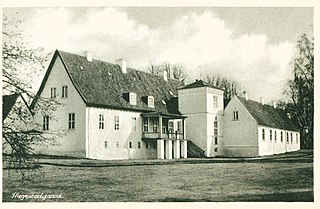Events from the year 1877 in Denmark.

Gjorslev is a cruciform medieval castle located 17 km south-east of Køge, on the Stevns Peninsula, Stevns Municipality, some forty kilometres south of Copenhagen, Denmark. Originally owned by the Bishop of Roskilde, it is considered one of the most well-preserved examples of Gothic secular architecture in Denmark.

Borreby Castle is a fortified manor house located near Skælskør, Slagelse Municipality, in the south-west corner of the island of Zealand, in eastern Denmark.

Rudbjerggaard, situated 7 km south of Nakskov, is the only half-timbered manor house on the island of Lolland in south-eastern Denmark.

Farumgård is a former manor house overlooking Farum Lake at Farum, Furesø Municipality, in the north-western outskirts of Copenhagen, Denmark. It is located just east of Farum Church and the original Farum village. The land has been sold off and redeveloped, except for the 6 hectares park which is laid out in the Baroque style.

Kongsdal, previously, Tygestrup, is a manor house and estate located approximately 14 kilometres (8.7 mi) southwest of Holbaek, between Undløse and Mørkøv, Holbæk Municipality, some 60 km west of Copenhagen, Denmark. The three-winged main building from the 1590s is listed.

Klintholm is an estate near Mons Klint on the Danish island of Møn. Originally owned by the Crown, since 1798 the estate has belonged to the Scavenius family. In 1838, a three-winged stone complex was built by G.F. Hetsch in the Neoclassical style and in 1875, a new manor house designed by August Klein in the Renaissance Revival style was completed but it was demolished in 2000.
Folehavegård is an 18th-century farmhouse in Hørsholm, Denmark. It has been owned by Karen Blixen's father Wilhelm Dinesen, as well as her younger sister Ellen Dahl, and was owned by the family for more than a hundred years. The main building, barn and stable are listed. Much of the land has been sold off. The remaining 35 hectares consist mostly of open farmland but adjoins the woodlands Folehaveskoven and Rungsted Hegn.
Gjedsergård is a manor house on the island of Falster in southeastern Denmark. It has been owned by members of the Tesdorpf family since 1847. The main building and the parallel building Kavalerfløjen are from 1768 and were listed on the Danish registry of protected buildings and places by the Danish Heritage Agency on 1 December 1959
Gammel Kirstineberg is a manor house located on the island of Falster in southeastern Denmark. The main building is from 1773 and was listed on the Danish registry of protected buildings and places by the Danish Heritage Agency on 5 March 1945.

Edward Tesdorpf, was a German-Danish landowner, agricultural pioneer and sugar manufacturer. He became the owner of ten estates; many were located in the Lolland-Falster area where he resided at Orupgaard near Nykøbing Falster, where he founded a sugar factory in 1884. Several of the estates are still owned by his descendants, including Gjedsergaard and Pandebjerg on Falster.

Hagestedgaard is a manor house and estate located at the village of Hagested, near Holbæk, Holbæk Municipality, some 60 kilometres west of Copenhagen, Denmark. The estate traces its history back to the 13th century but the current asymmetrical complex of single-storey, white-washed buildings surrounding a central courtyard was constructed for Hans Didrik Brinck-Seidelin in 1747 with the exception of the remains of a tower built by Johan Friis in 1555. The estate has been owned by members of the Castenskiold family since 1769.
Gunderslevholm is a manor house and estate located 12 km northwest of Næstved in southeastern Denmark. Gunderslevholm has been owned by members of the de Neergaard family since 1803. The main building is located on high ground just west of the Susaa river. It was originally a Baroque-style mansion built in 1729 for Carl Adolph von Plessen but was in 1787 adapted to the Neoclassical style. Gunderslevholm covers 2,020 hectares of land and 276 hectares of lake (2023).

Hærbygaard is a manor house and estate located on Tuse Næs, Holbæk Municipality, some 80 kilometres west of Copenhagen, Denmark. The current main building was constructed for Melchior Grevenkop-Castenskiold in 1861-62 and later expanded with a new north wing by Gotfred Tvede in 1900-1901.
Store Frederikslund is a manor house and estate located eight kilometres northeast of Slagelse, Slagelse Municipality, Denmark. It is one of several estates that was established when Antvorskov Cavalry District was sold in public auction. It was established by General Hans Henrik von Eickstedt in 1783 and later owned by the Castenschiold/Grevenkop-Castenschiolds family from 1786 to 1995. The Neoclassical main building from the 1780s was probably designed by Andreas Kirkerup. It was listed on the Danish registry of protected buildings and places in 1918.
Basnæs is a manor house and estate located southeast of Skælskør, Slagelse Municipality, Denmark. The Gothic Revival style main building is a three-storey building with three corner towers designed by Gustav Friedrich Hetsch. The estate covers approximately 1,000 h4ectares of land.

Peder Brønnum Scavenius was a Danish landowner and politician. He was the owner of Gjorslev on the Stevns Peninsula, Klintholm on Møn and Petersgaard at Vordingborg. He was an also involved in politics and by royal appointment a member of the Danish Constituent Assembly.

Stormgade 8 is a three-storey, 18th century property situated at Stormgade 8 in Copenhagen, Denmark. The buildingwas listed in the Danish registry of protected buildings and places in 1918.

Bredgade 45 is a former town mansion situated around the corner from Frederik's Church in the Frederiksstaden district of central Copenhagen, Denmark. Origibnally constructed as an extension to the adjacent Moltke Mansion, it owes its current Historicist design to a renovation undertaken by Vilhelm Dahlerup. Notable residents include Governor-General of the Danish West Indies Peter von Scholten, naval officer Steen Andersen Bille, landowner Peder Brønnum Scavenius and businessman and art collector Heinrich Hirschsprung. The property is now owned by Jeudan. Female Founders House, a hub for femakle entrepreneurs, is based in the side wing.













